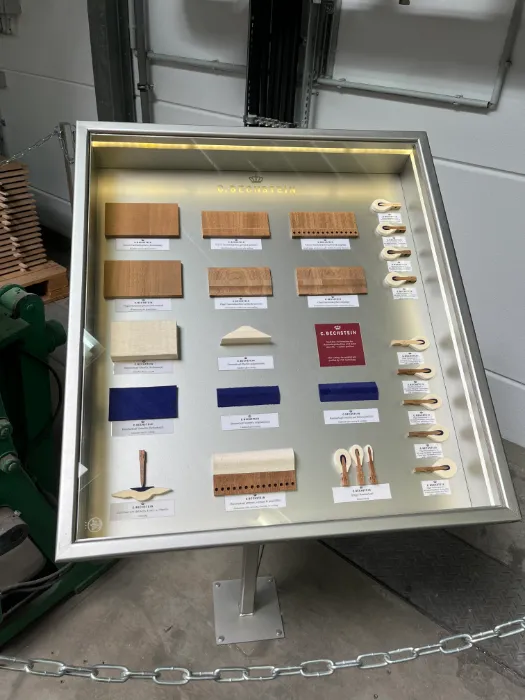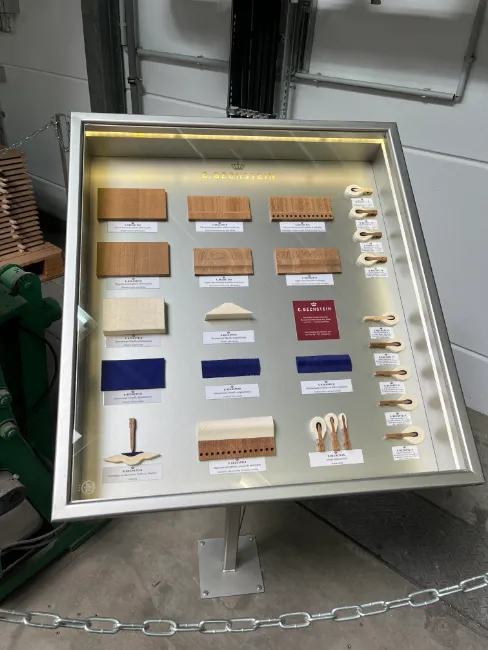New Hammerheads from C. Bechstein: Piano Hammers

During my Tour of the C. Bechstein Factory in Germany, I was able to learn more about production of piano hammers before taking a 3 day Damper installation class.
The primary reason this display case is so unique and important is because I learned that Bechstein began to produce its own hammerheads in 2012.
Thanks to a major monetary investment into the C. Bechstein R&D Department, 2 years of testing & trade research, Bechstein began the production of C. Bechstein hammerheads for pianos, which is very uncommon within the piano industry.
This is significant because Bechstein is one of the only piano companies in Europe (with a showroom in Berlin) to produce their own hammers.
While Bechstein is extremely traditional, it is necessary for the company to innovate, which has always been part of its core values. In the case of hammer production, Bechstein innovated to produce high quality hammers to meet their standards in a timely fashion.
Has Bechstein Always made their own hammers?
Bechstein previously worked with Renner USA who is a well known and popular supplier of piano actions and hammers within the piano industry, however, this often required long wait times of over one year.
Additionally, while the quality of Renner hammers is high, often, specifications set by Bechstein engineers were not precisely met. In-house production of hammerheads afforded Bechstein greater control over the qualities desired from a piano hammer.
Due to internal dialogue at Bechstein to always question whether to manufacture or source their materials, the decision was made to produce their own German hammerheads as well as action parts which improved quality control and timeliness of supply.
Bechstein Hammerhead Display Case
This display case I found was very well put together, so I was curious to learn about how the components come together to produce a C. Bechstein Hammerhead.
Which Wood & Felt are used in Bechstein Hammers?
Wood (Walnut, Mahogany, Maple) and felt (Wurzen) are the primary elements of what makes up C. Bechstein piano hammerheads.
The wooden cores are selected to meet the sound ideals, nuanced voice, and desired dynamic range of each model of piano produced by the company.
For instance, a C. Bechstein concert level instrument should achieve a high level of projection, whereas a living room piano should achieve a traditional sound within the home environment.
Additionally, the shape and the weight of the felt are chosen specifically to achieve the attributes listed above.
The felt is made from natural materials of the very best quality by the Wurzen felt Manufactory. Wurzen is a town in Germany where this factory produces all sorts of felt, not just for pianos.
For Bechstein, it is necessary that the hammer materials meets internal standards specified after all is said and done. Same goes for all action parts that make up their pianos.
Upright Piano Wooden Core Process
Here are the 3 major steps involved in producing the upright piano hammer core before compressing the felt onto the finished pieces.
1. Wooden core for upright piano
Wooden cores may come in Walnut, Mahogany, or Maple.
2. Upright piano wooden core after milling
The contour of the hammer is specifically cut for each section of the piano.
3. Upright piano wooden core after drilling & cutting into pieces
Hammer shanks will meet the hammer core at the drilled location.
Grand piano wooden core Process
The grand piano hammer wooden cores also go through a similar 3 step process before felt is compressed onto the top of them.
1. Wooden core for grand piano
Grand piano wooden cores also come in Walnut, Mahogany, and Maple.
2. Grand piano wooden core after milling
The tails of Grand piano wooden cores are shaped differently so that the back checks can “catch” the tail.
3. Grand piano wooden core after cutting into pieces
The wooden cores are cut into pieces, although not yet drilled in this photo.
Mainfelt processing
Another 3 step process is necessary for the mainfelt to undergo before it is compressed to the top of the wooden core. The 3rd step is not pictured, but has a small placard describing the process that takes place. Hammer head production is proprietary information and remains a trade secret within the industry.
1. Mainfelt before cutting
The density and weight of this felt must meet specifications by Bechstein engineers before proceeding.
2. Mainfelt after cutting
The felt is cut to a shape which will be wrapped around the wooden core of the hammer head.
3. Mainfelt Profiling (Not Pictured)
This placard describes the process of profiling the felt following cutting of the Mainfelt.
After cutting, the mainfelt gets profiled by CNC technology.
Bechstein uses proprietary CNC technology to make many of the materials for piano, including the bridge, hammers, piano action, and other piano parts.
These enormous machines produce exact replicas of piano parts with a high degree of accuracy and consistency.
All other tasks unsuitable for CNC are necessarily done by experienced factory technicians to ultimately produce the handmade pianos.
Underfelt Processing
The underfelt is a layer underneath the mainfelt. It provides structural integrity between the wooden core and the mainfelt, which strikes the piano string.
This is an often overlooked yet vital component that directly transfers the kinetic energy from the piano key into acoustic energy in terms of sound, which acoustic pianos can achieve in unparalleled experience as opposed to digital pianos.
Its 3 step process can be seen below.
1. Underfelt before Cutting
Again, the felt is weighed and measured with special tools that use bright light to measure the density of the felt to verify that it meets standards.
2. Underfelt after cutting
The felt is cut to be wrapped around the core as well as to meet the contour of the mainfelt.
3. Underfelt after cutting & sanding
Sanding gives definition to the shape of the underfelt in the final step before the hammer head can be fully assembled.
What makes a Bechstein Hammerhead complete?
With all of the above steps complete, the hammer finally gets compressed to the wooden core.
To Review:
The interchangeable wooden core (Walnut, Mahogany, Maple) provides the density of wood desired to achieve the correct sound profile for any given model of Bechstein upright pianos and grand pianos.
The underfelt aids in transferring energy properly to the mainfelt, which is more dense to widthstand the repetitive energy transfer between both the wooden core and the mainfelt.
The mainfelt, which strikes the strings, is to be stitched on by piano technicians with high precision during the process of voicing to achieve a final result.
Centering
This is the step by which hammer felt is centered to the core during the felt compression process.
Hammerset after pressing, cleaning & sanding
The felt is wrapped around the core which necessarily puts the felt in tension. This is a very important aspect of the piano hammer that piano technicians must keep in mind during voicing, which is an art form in and of itself.
Hammerheads are different sizes, shapes, and weights depending on whether the hammer is located on the low end or high end of the piano, whether the hammers are in an upright or grand piano, and lastly, depending on which model of piano the hammers should belong.
For example, the thick hammer will strike bass strings and the thin the high treble strings.
Hammerhead
A complete Hammerhead is shown! This completes the process of hammerhead production within the display case that I found during my Bechstein Factory Tour.
As was mentioned before, the wooden core, the size, the specific weight, and shape of the felt determine the different sounds that are uncovered while playing the piano.
What are the hammer cores made of in each Bechstein?
Wooden hammer cores are selected and applied to 3 broad categories of piano models designed and produced for Bechstein pianos.
C. Bechstein Concert instruments all have a walnut core for projection
C. Bechstein Academy instruments all have a mahogany core for a traditional sound
W. Hoffmann uprights and grands have a mahogany or maple core depending on the model
From top (1) to bottom (5) the following descriptions are what’s written for these grand piano hammers within the display case.
Grand Piano Hammerhead Size 1 with a maple molding
Grand piano Hammerhead Size 1 with a mahogany molding
Grand Piano Hammerhead Size 1 with a walnut molding
Grand Piano Hammerhead Size 2 with a walnut molding
Grand Piano Hammerhead Size 3 with a walnut molding
From top (1) to bottom (4) the following descriptions are what’s written for these upright piano hammers within the display case.
Upright piano Hammerhead Size 1 with a maple molding
Upright piano Hammerhead Size 1 with a mahogany molding
Upright piano Hammerhead Size 1 with a walnut molding
Upright piano Hammerhead Size 2 with a walnut molding
What happens after Bechstein hammers are produced?
Even after production, expert technicians at Bechstein will stitch on the felt with high precision for greater movement of the fibers to strike the ideal balance between tension and elasticity for optimal piano tone depending on the model of instrument.
The procedure called voicing produces rich sound and takes years of experience for qualified technicians to master this art form.
I have included a link to an article of mine that I wrote about a technician named Eric Johnson who delivered a class at a Piano Technician’s Guild meeting titled “Practical European Voicing."
Questions?: Contact Kevin

















